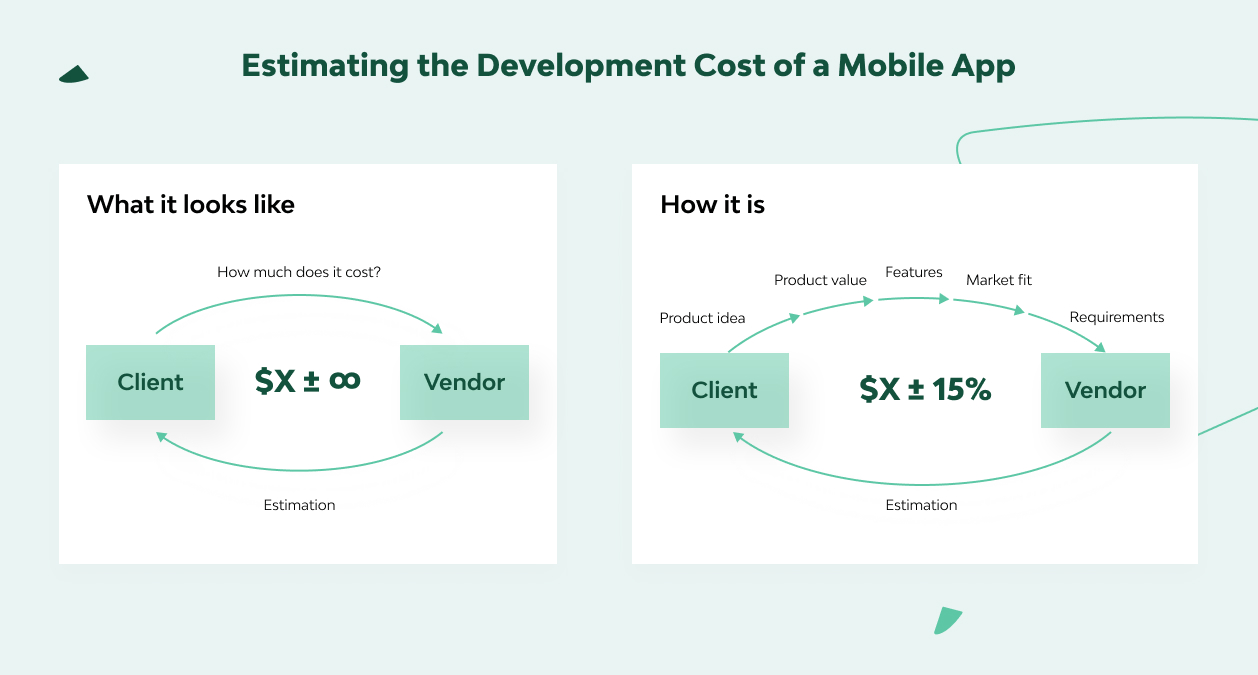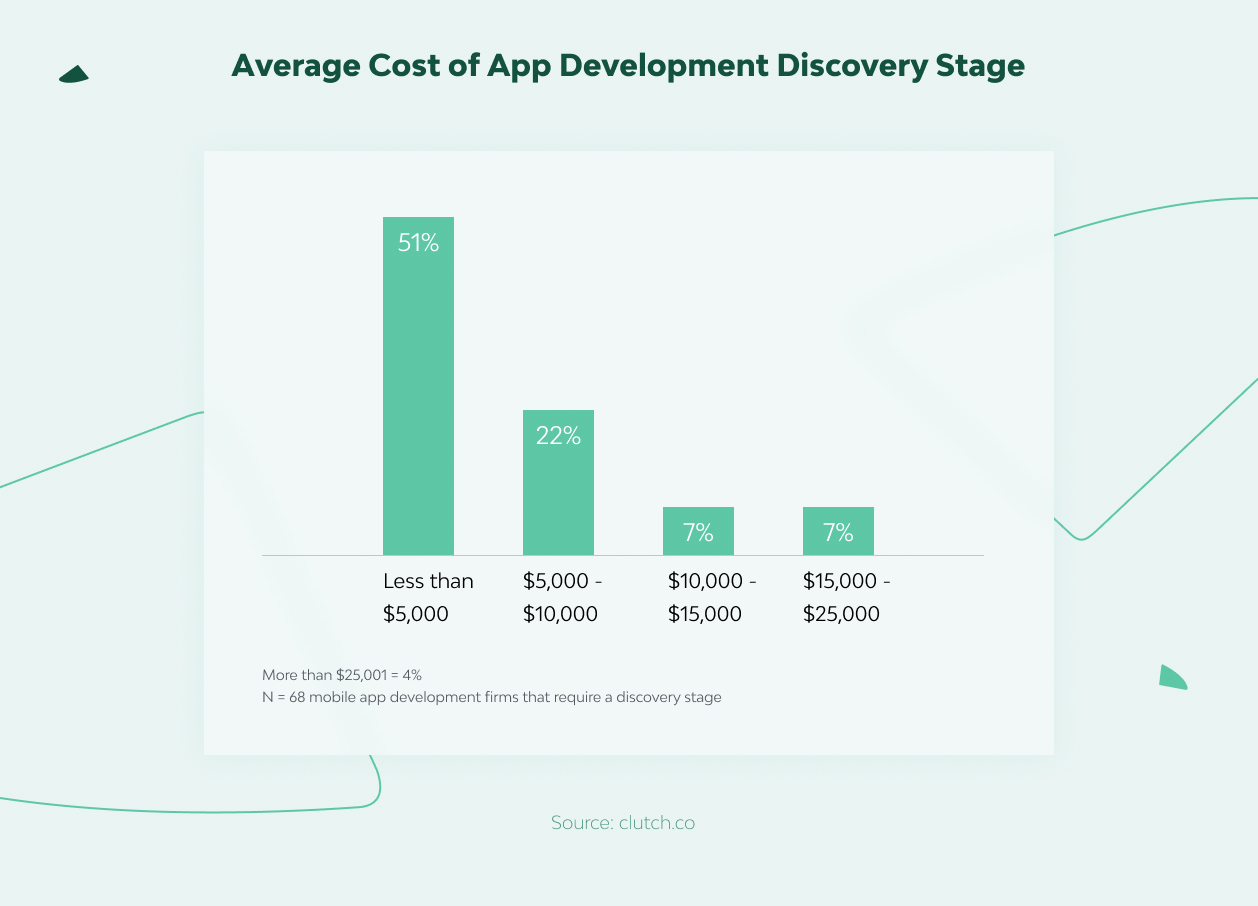How Much Does It Cost To Develop A Mobile App?

When asking how much it costs to develop an app, it’s important to know whether you’re looking for a rough estimate or a detailed one. The thing is, the detailed estimate isn’t going to happen at the initial stage of the negotiations. The vendor will need detailed specs (requirements) of the future product to calculate a detailed price. A general phrase like “I have an idea for a delivery app” isn’t enough here, because the estimate will be just as vague and imprecise.
So how can you create a mobile app development cost breakdown so you know how much you’ll need to invest? Until you have detailed your requirements, you’ll have no precise sum. The cost of creating a mobile app depends on many factors. But we can give you a general overview of how a mobile application development cost is formed.
Where Are App Development Prices Heading in 2024?
The global app development market is expected to double in the next ten years. In 2023, the market capitalization was 167 billion dollars with a CAGR of 7.8%. And in 2032, it will likely hit 328 billion.
The amount of app developers is also growing. In 2014, about 8.7 million programmers worldwide were developing mobile apps, but now this number has almost doubled.
App market diversity is sky-high and continues to grow. Competition between developing companies is also increasing, but the average development prices remain almost the same. The main reason for that is the development technologies have become more complex. Creating an app that matches all modern market requirements takes 2-3 times longer and requires more specialized expertise than ten years ago.
However, creating unique and first-of-its-king apps become even more pricey than earlier. It’s because of stricter requirements for personal data protection and different technology compatibility issues.
Approximate App Development Cost in 2024
The average cost to develop an app can vary significantly based on factors such as complexity, features, and platform. It typically ranges from a few thousand dollars for basic apps to potentially hundreds of thousands for more complex, feature-rich applications.
The prices of a simple app and something as elaborate as, say, Uber (or Azyan, which we developed) will be very different.
For a rough ballpark, take a look at the mobile app development cost indicated by leading developers at Clutch, where project costs vary depending on the complexity of the job:
- Minimum-size apps usually have basic functionality for a small number of users and neither a database nor social media integration. These can be applications for companies engaged in logistics, education, infrastructure, or that provide similar services in a local market. The cost of development for such an app will range from $10,000 to $100,000.
- Mid-level apps that include database and social media integration. Such functionality is in high demand in retail, fintech, travel, and B2B (for example, CRM development). Also, innovative approaches based on VR, AI and integration with IoT can be actively used here. The cost of developing a mobile app in this category can be up to $200,000.
- High-level apps with features like extensive databases, advanced graphics, and e-commerce integration. This app group includes many large companies in the e-commerce, delivery, healthcare, fintech and proptech (real estate, mortgage) sectors. Here, you can find high-load B2C (for example, video and photo exchange services) and enterprise solutions that fall within the $200,000 to $999,000 range.
- Finally, there is a group of projects whose development costs exceed $1,000,000. This amount usually applies not so much to mobile applications but to complex projects that have been on the market for a long time. It typically includes the development cost of a web application, maintenance costs, etc.
What will be the app development cost in your case? Before all the requirements are collected and analyzed, there’s no precise dollar amount. It depends on how complex the product is, including integrations, the use of IoT and/or sensor features of the smartphone, security, etc. It also matters whether it’s working with high data loads and on the number of users it’s intended for. (Is it a general public app like Instagram? Or is it a domain-specific app — for medical workers, for instance?) Thus,
If someone claims to give you a precise mobile app cost estimate at the initial negotiation stage, it can’t be a true estimate. It’s impossible to estimate the cost of a product without detailed info about its specifications and features.
Moreover, the estimate that’s supposedly detailed at this stage will most likely change. And the difference will be the greater if you can’t provide much information at the beginning of the journey.
In other words, don’t let ill-conceived numbers mislead you. And check out the considerations we take into account when forming a rough quote.
Read Also: How Much Do Software Developers Make per Hour?
Factors that Influence the Cost of Developing a Mobile App
Prototype vs. Full functionality.
Depending on what we’re developing, the cost will differ. An MVP costs much less than a fully functional app. We always recommend starting with an MVP, testing it on the market, and then proceeding with the full functionality. The reason is that users will probably provide valuable feedback, and the product will have to be adjusted to their needs. If you’re interested in effective iteration design, read our article on MVP, MMP, MLP, MDP, and MAP startup stages.
Custom apps vs. Off-the-shelf solutions
Will the product be unique? Of course, tailor-made app development is more expensive. But it promises more benefits in terms of the app’s operation, as it can be made to suit the exact business needs. Also, if you leverage the experience of existing products (Uber, for instance), your path can be noticeably more straightforward in development but more challenging in terms of market competition.
Native vs. Hybrid
If you need to run your app on iOS and Android, you have two options. The first is to develop them separately (i.e., natively) for each platform. In this case, the development cost increases two-fold. The second is to create a hybrid app that can run on both platforms. This way, it’s more challenging to achieve high performance, but you’ll have a single team aware of the ongoing development for both platforms.
Time and Money Vs. Fixed Price
When asking “How much does it cost to build a mobile app?” one shouldn’t overlook another weighty question. It’s about which business engagement model you prefer. In regard to the type of contracts, there are two options:
- The Fixed Price model, where you pay for a fully developed app. This option requires particularly careful planning and risk management from you. It’s suitable for small applications because once the scope of work is approved, you’ll have almost no opportunity to change something.
- The Time and Material model, where you pay for actual time and resources used by developers to create the app. This approach provides more flexibility and the ability to clarify something in case of a misunderstanding or to adjust requirements based on new data. However, this model makes it more difficult to plan a budget in advance and predict the exact development time.
There are many other interesting aspects of this topic, so it makes sense to refer here to our corresponding article on Engagement Models.
Cost of App Development by Region
The average development rate is very different across the world. It also significantly affects the final price of creating a mobile app. For example, hiring a programming team from Silicon Valley will cost much more than signing a contract with a high-class Ukrainian development agency.
Here are the approximate price rates of development agencies in different countries:
| Country | Price rate per person-hour, $ |
|---|---|
| USA | 150-200 |
| UK | 125-175 |
| Canada | 100-150 |
| Australia | 125-175 |
| Spain | 100-150 |
| Germany | 150-175 |
| Austria | 100-150 |
| Finland | 100-150 |
| Israel | 150-200 |
| Ukraine | 50-100 |
| Poland | 75-125 |
Diversification of the development geography is the best strategy nowadays if you want to design high-quality apps at an affordable price. For example, many Ukrainian companies offer customers the same conditions and services as American ones but almost twice as cheap.
Breakdown the Cost of Various Development Stages
When calculating how much it will cost to build a mobile app, consider the phases of your development process. The contribution of each phase to the final cost of the project may differ.
What needs to be covered? In terms of advancing from idea to a working app, there are two major stages: planning which involves business analysis, and development, which involves backend and frontend development, UI/UX design, and QA.
Planning and Business analysis
Before start building the app logic, you need to have or look into at least the following:
- A proven problem statement (and how well the decision to develop a mobile app corresponds to it)
- Business model feasibility (target market, competitors, monetization, etc.)
- Legal constraints/barriers (is it even permissible to run such an app for your target market?)
Have you got all the requirements you need to start? If not, a Discovery Phase service will help you to create a “Pitch Package” with a clearly developed business model, product value proposition and development requirements. The “Pitch Package” can be effectively used during negotiations with potential investors or developers.
You can get a rough idea of Discovery phase costs from the chart below.
Please note that these are only averages (that say nothing about the specifics and prospects of the projects). The exact amount of money highly depends on the size of the team and the time it takes to complete this phase. If the team involved is small and the Discovery phase is short, the cost will be just over $5,000. But if the team is large and the work takes longer, expect the cost to be at least three times higher.
Ideally, a team assigned to the Discovery Phase will include a Business Analyst (BA), Project Manager (PM), Solution Architect, and UI/UX Designer. Note that in the early stages, when the foundation for a future project is laid, it’s especially important not to skimp on senior-level specialists.
Development Process and What Affects Its Costs
Due to its practicality, Scrum is one of the most popular approaches to software development management. At Django Stars, we use it to build our processes (and modify it according to the specifics of the company and project). In Scrum, you split the app development process after the preparatory phases (Discovery and Pre-Development) into short periods called sprints. The result of each sprint is a workable version of the product. This allows you to try your app immediately, get feedback, and analyze the prospects for further development. Thus, the cost of the development phase can be determined by multiplying the cost of one sprint by their number.
Having a workable version of the app strengthens your position in negotiations with investors. And after the app’s release, you can start using your profits to recoup any further app development costs.
Usually, before becoming successful, an app needs 3 to 10 releases in order to mature, or another way to look at it until the cost of obtaining new users becomes less than the profit obtained from the app (self-perpetuating cycle). Even for a relatively simple application, be ready to spend at least 3 months on developing the first version and then one month for each new update.
Backend
Except for backend features, the cost of an app development may vary depending on its planned architecture and infrastructure.
From an architectural point of view, it matters where you plan to host your application, as the site/store requirements need to be taken into account. Such things as using cloud services (Microsoft Azure, AWS, Google Cloud) or a defined Service-Level Agreement (SLA) for the app will affect the app’s logic. Also, you should inform the software vendor in advance about the expected number of users (don’t forget further scaling) and about high availability requirements (i.e., the app’s resilience to possible failures and downtime that is crucial, for example, in fintech).
For the backend engineering, the following questions matter:
- Are there any preferences regarding technology stack/programming language?
The right choice of technology can help the team reduce development complexity by leveraging relevant libraries with commonly used solutions.
- How will users make payments? (If payments are necessary.)
A selection of available methods — within the app, via credit card, or biometric payment — can affect the app’s security/encryption requirements. Here you may also need to select a payment gateway. In addition, the percentage charged by payment systems per transaction may differ.
- What devices/services/sensors should your application be compatible with?
The cost of mobile app can be reduced if you’re developing an app only for specific devices. The list of supported devices can be based on what specific device sensors and hardware capabilities you plan to use (such as video camera, geolocation, gyroscope, etc.).
- Will the app have to connect with wearables or Internet of Things devices?
This may require integration of additional APIs.
- Does the app need to work offline?
Such a need can affect solutions in terms of data storage and synchronization, which is especially challenging in situations where updates to the same file come from several users.
- What data do you need to get from the app?
Depending on the app, you may be interested in tracking
– downloads per platform,
– % of downloads that have been fully installed,
– number of active users,
– what features are being used the most,
– how frequently the app is being used,
– session length,
– push notifications activated,
– how many transactions were made, etc.
All these points must be consistent with the requirements of the sites where you plan to host your Django application.
- Is there a need to integrate the app with external systems?
(Examples of such systems are Salesforce and SharePoint.)
This list can be expanded. Backend tasks also include database integration, building the main system flow (i.e. models of the activities and decisions the app should execute), determining what features are needed for admin/customer support, etc. But what is important for this article is that each integration or feature implementation takes time and effort that will affect the price.
For example, a simple app integration with maps takes about 20 hours of development. But if you need features like route planning or push notifications when the user’s location changes, that development time should be at least tripled.
Frontend
Modern applications must meet the exacting expectations of users in terms of frontend logic. As a simple example, we can take the loading speed of an interface. Today users don’t want to look at progress bars, which means that when choosing a framework, you’ll want to consider whether it provides reactivity.
If you have preferences regarding frontend frameworks, you need to discuss them with the vendor right away. Otherwise, the choice to use standard solutions (that can reduce development time) can be based on the experience of the developers.
The compatibility requirements of the application will also affect frontend development. This includes support for devices (tablets and mobile), web browsers, and mobile operating systems and their versions.
The difference between native and hybrid (mentioned above, as one of the factors that most affect the cost of creating a mobile app) also refers specifically to the frontend. When developing a hybrid app, frontend developers should solve the problem of combining the functionality of both operating systems. At the same time, it’s necessary to avoid conflicts and situations when the function is in the application but is inaccessible to the user due to the limitations of the OS.
Another example of tasks where the frontend meets the UI/UX is the display of complex data sets (such as tables) in the limited display space of a smartphone. In many ways, this is influenced by the thoughtful building of the User Flow, especially when your app invites its user to fill out forms with a lot of questions and you don’t want to scare him away.
By the way, consider the issue with Login Walls, i.e., pages that don’t allow the user to proceed with the app until the user is authorized. It’s very annoying to memorize and then type passwords in the many different applications that users deal with daily. One way to get around this inconvenience is to sign in with social media. But the complexity of their integration may vary. And whatever solutions you choose, information security must be ensured at a high level.
The fewer barriers for the user, the more expensive it will be to develop the application. Each decrease in the number of barriers entails additional integration and the need to ensure the security of this integration.
Design
The design complexity of an application often depends on its distribution model. For B2C applications, it’s important to align with modern UI/UX trends since the competitiveness and attractiveness of your application directly affects how many customers you’ll have. In Line of Business (LOB) applications, fancy style or tricky animations are less important than functionality, and cases as described above (in regard to fitting a lot of detail on a small screen) come to the fore. On the other hand, corporate guidelines are important for LOB applications. By prioritizing intelligently, you can determine where you can save money.
The design of the mobile app is also influenced by where users are supposed to find it. It will define whether the app needs:
- Compliance with the design guidelines of each store (App Store, Google Play);
- An impactful icon (based on claimed value for users);
- A video demonstration (to drive conversions);
- App store optimization (targeting the right words).
If possible, show the vendor other apps that you want to be used as inspiration. This helps the team get into the founder’s head.
Prototyping shouldn’t be neglected either, as it will save time and money that you’ll otherwise spend on developing untested solutions.
QA
Another way to lower the cost of mobile app development is to involve a quality assurance engineer (QA). While you might say this means paying an extra hourly rate, it’s unlikely to outweigh the cost of the mistakes you’ll avoid. It’s important to understand that QA is not so much about checking for bugs and fixing them but about ensuring that the app is being developed according to the agreed-upon requirements and expectations.
PM
This is a cost item that software vendors often allude to in passing. To coordinate all the participants, the team needs a project manager (PM) who facilitates and controls all the processes and ensures the team works as efficiently as possible. Good project management is helpful in terms of avoiding downtimes and making the development process go faster, which eventually means reducing the development cost of a mobile app.
Generally speaking, it makes sense to clearly understand the roles and responsibilities in the Software Development Life Cycle to make the process run smoothly.
App Development Cost Examples
For a visual comparison, here’s a table with three examples of companies from our portfolio for whom we’ve developed mobile apps of varying complexity.
| Example | Simple App | Medium Complexity | App-based Company |
|---|---|---|---|
| Name | StoryTold (United States) | PADI Adventures (Switzerland) | Azyan (Jordan) |
| Description | An innovative app focused on improving parent-child relationships through storytelling. StoryTold works on Android smartphones and tablets, as well as iPhone, iPad, and iPod Touch. | A global booking platform for scuba divers provides the widest selection of liveaboards, dive resorts, and dive centers worldwide, and the option to book and pay from the same place. | Azyan offers food-delivery services and delivers thousands of items a day. It connects clients, restaurants, and delivery service providers through the app to make the order and delivery process smooth and rapid. |
| Features | StoryTold allows the parent to write stories and messages on the web version of StoryTold, which their children can read on their mobile phones. | Wherever you are, the geo-based PADI Travel mobile app will help you find activities you’re interested in. It can display dive centers around you, show you where to rent diving equipment, allow you to book a lesson and pay for these things easily. | Mobile app for drivers shows drivers incoming offers and gives the option to accept or deny them. It’s connected to a map with pickup locations, route directions, and ETA. Also, it provides users with an order shipping confirmation option. |
| Services provided | Full-cycle software development (backend/frontend/mobile), UI/UX design, QA, BA, DevOps, maintenance. | Full-cycle software development (backend/frontend/mobile), QA, DevOps, maintenance. | Full-cycle software development (backend/frontend/mobile), QA, UI/UX design, DevOps, maintenance. |
| A well-known app of approx. similar complexity | Telegram | Booking.com | Uber Eats |
Read more: How to develop a food delivery app
How to Reduce Mobile App Development Cost
Developing a high-quality app can’t be cheap, but some tips will help avoid overpaying for these processes. Here you go.
Carefully set the goals and design development plans
At the beginning of the development process, you must clearly understand what kind of an app you need. First, you must conduct deep market and competitor analysis, gather your target audience demographic characteristics, and set general goals for an entire project.
According to PMI analysis, 37% of technological projects fail because of poor planning and a lack of clear goals.
We recommend managers discuss all project features with a development team. It will help a company to design a complete vision of the product. With the expertise of experienced developers, the planning process would be easier and more accurate.
Hire a developers team with experience in creating mobile apps
Even if a company has developers in-house, we recommend outsourcing the development. Designing a full-fledged and scalable mobile app, especially a cross-platform one, requires vast expertise in various technologies.
In our experience, 8 of 10 companies that are sure they have all the required in-house expertise to develop a mobile app are wrong. In the end, designing an app with the help of professionals is even cheaper than trying to do it in-house.
Design prototypes and MVP
Proper UX is crucial for a mobile app. That’s why, at the early development stage, it’s vital to create clickable prototypes to simulate how potential clients would perceive the app.
Using design tools is way cheaper than complete app development, but it clearly shows whether the future application will be user-friendly.
When UX issues are solved, the next stage is creating MVP. It’s a functional app with the most essential features. MVP needs a deep analysis with the help of representatives of the target audience. If it’s done right, managers and developers will get precious insight into how to make the app even better and what new features users may lack.
As a result, the app would better meet the target audience’s preferences and generate better profit.
Create a cross-platform app
Developing a cross-platform app may be pricey, but it saves a lot of money for a company.
If you create separate apps for iOS and Android operational systems, you need two teams to maintain and support them. There are different issues with operating and analyzing data in databases. Moreover, updates must be designed separately by using different tech stacks.
Creating a cross-platform app costs more than developing separate apps, but it’s more convenient and much cheaper for further use.
Takeaways
All the estimates stated above are rather theoretical. Real-life practice is more complicated.
There is a big difference between just building an application and building a really effective app. The latter may take years to start sidestepping its rivals, so you can’t predict how much it will cost.
Before you start building a mobile application, it makes sense to weigh its pros and cons and consider the following options:
- Reducing the scope of the app’s functionality to lower development costs;
- Exploring alternatives to find better ways to achieve the same goals.
Creating a successful mobile application takes a lot of thought regarding the concept of the app, its design and user-friendliness, monetization method, etc. Its final app development cost will depend on the app’s type, the platform, its features and functionalities, and so on. It should have an elaborated UI, backend and other advanced features.
And these are just a few facts and aspects of the cost structure of app development and its post-release expenses.
By the way, if the topic is relevant to you, I invite you to watch my YouTube video where I explain how to estimate software development project costs in 2021.
Where to start if you’re willing to create an iOS or Android app? Tell us about your idea or send us a documented description or specification. First, we’ll do a rough estimate for the app based on the approximate number of hours needed to build it. After you approve the rough estimate, we will identify requirements for each stage of development and present you with a more detailed estimate.
- What are the hidden costs of mobile app development?
- The most common hidden mobile app development costs are software licenses, server and cloud services fees, ongoing financial and technical auditing, user support, purchasing third-party APIs and collaboration tools, App Store and Google Play fees, ongoing app maintenance, etc.
- How much does it cost to develop a more complex app?
- It depends on its features. A full-fledged cross-platform app with numerous complex features may cost over $200,000.
- How can I get an accurate cost estimate for my app?
- Contact us and tell us your app idea. We will carefully calculate the development cost and inform you about all possible difficulties and ways to avoid them.
- Should I opt for offshore or onshore development to save costs?
- It depends on where your company is situated. For Northern American or Western European enterprises, it’s better to outsource development. The development price rate, for example, in Ukraine, is two to three times less than in the USA or UK.









